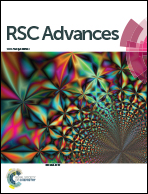Synthesis and biological evaluation of novel carbazolyl glyoxamides as anticancer and antibacterial agents†
Abstract
A new library of 24 carbazolyl glyoxamides 14a–x were designed and synthesized from glyoxalic acids and arylamines in the presence of HATU as a coupling reagent under MW irradiation. The synthesized carbazolyl glyoxamides were evaluated for their in vitro anticancer and antibacterial activities. Of the synthesized carbazolyl glyoxamides, compounds 14l and 14q exhibited the most potent cytotoxicity towards a breast cancer cell line with IC50 values of 9.3 and 9.8 μM, respectively. Further, caspase-3 assay for carbazolyl glyoxamides indicated that these compounds induced apoptotic cell death in Jurkat cells. Furthermore, some of the synthesized carbazolyl glyoxamides 14g, 14k, 14l and 14n exhibited comparable or even better antibacterial activity (MIC = 8–16 μg mL−1) than chloramphenicol against the selected bacterial strains.


 Please wait while we load your content...
Please wait while we load your content...